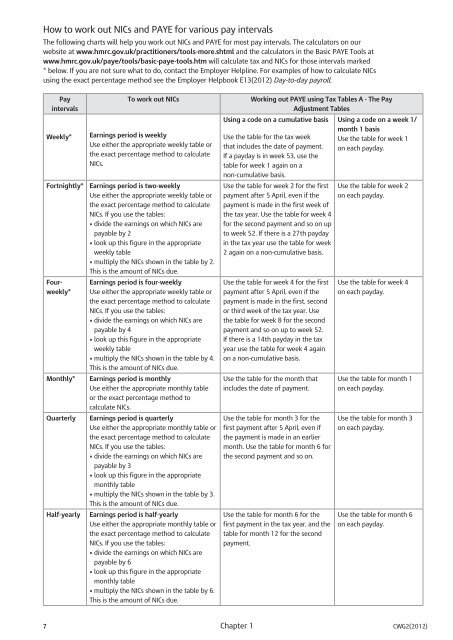Employer Further Guide to PAYE and NICs - HM Revenue & Customs
Employer Further Guide to PAYE and NICs - HM Revenue & Customs
Employer Further Guide to PAYE and NICs - HM Revenue & Customs
You also want an ePaper? Increase the reach of your titles
YUMPU automatically turns print PDFs into web optimized ePapers that Google loves.
How <strong>to</strong> work out <strong>NICs</strong> <strong>and</strong> <strong>PAYE</strong> for various pay intervals<br />
The following charts will help you work out <strong>NICs</strong> <strong>and</strong> <strong>PAYE</strong> for most pay intervals. The calcula<strong>to</strong>rs on our<br />
website at www.hmrc.gov.uk/practitioners/<strong>to</strong>ols-more.shtml <strong>and</strong> the calcula<strong>to</strong>rs in the Basic <strong>PAYE</strong> Tools at<br />
www.hmrc.gov.uk/paye/<strong>to</strong>ols/basic-paye-<strong>to</strong>ols.htm will calculate tax <strong>and</strong> <strong>NICs</strong> for those intervals marked<br />
* below. If you are not sure what <strong>to</strong> do, contact the <strong>Employer</strong> Helpline. For examples of how <strong>to</strong> calculate <strong>NICs</strong><br />
using the exact percentage method see the <strong>Employer</strong> Helpbook E13(2012) Day-<strong>to</strong>-day payroll.<br />
Pay<br />
intervals<br />
Weekly*<br />
To work out <strong>NICs</strong> Working out <strong>PAYE</strong> using Tax Tables A - The Pay<br />
Earnings period is weekly<br />
Use either the appropriate weekly table or<br />
the exact percentage method <strong>to</strong> calculate<br />
<strong>NICs</strong>.<br />
Fortnightly* Earnings period is two-weekly<br />
Four-<br />
weekly*<br />
Use either the appropriate weekly table or<br />
the exact percentage method <strong>to</strong> calculate<br />
<strong>NICs</strong>. If you use the tables:<br />
• divide the earnings on which <strong>NICs</strong> are<br />
payable by 2<br />
• look up this figure in the appropriate<br />
weekly table<br />
• multiply the <strong>NICs</strong> shown in the table by 2.<br />
This is the amount of <strong>NICs</strong> due.<br />
Earnings period is four-weekly<br />
Use either the appropriate weekly table or<br />
the exact percentage method <strong>to</strong> calculate<br />
<strong>NICs</strong>. If you use the tables:<br />
• divide the earnings on which <strong>NICs</strong> are<br />
payable by 4<br />
• look up this figure in the appropriate<br />
weekly table<br />
• multiply the <strong>NICs</strong> shown in the table by 4.<br />
This is the amount of <strong>NICs</strong> due.<br />
Monthly* Earnings period is monthly<br />
Use either the appropriate monthly table<br />
or the exact percentage method <strong>to</strong><br />
calculate <strong>NICs</strong>.<br />
Quarterly Earnings period is quarterly<br />
Use either the appropriate monthly table or<br />
the exact percentage method <strong>to</strong> calculate<br />
<strong>NICs</strong>. If you use the tables:<br />
• divide the earnings on which <strong>NICs</strong> are<br />
payable by 3<br />
• look up this figure in the appropriate<br />
monthly table<br />
• multiply the <strong>NICs</strong> shown in the table by 3.<br />
This is the amount of <strong>NICs</strong> due.<br />
Half-yearly Earnings period is half-yearly<br />
Use either the appropriate monthly table or<br />
the exact percentage method <strong>to</strong> calculate<br />
<strong>NICs</strong>. If you use the tables:<br />
• divide the earnings on which <strong>NICs</strong> are<br />
payable by 6<br />
• look up this figure in the appropriate<br />
monthly table<br />
• multiply the <strong>NICs</strong> shown in the table by 6.<br />
This is the amount of <strong>NICs</strong> due.<br />
Adjustment Tables<br />
Using a code on a cumulative basis<br />
Use the table for the tax week<br />
that includes the date of payment.<br />
If a payday is in week 53, use the<br />
table for week 1 again on a<br />
non-cumulative basis.<br />
Use the table for week 2 for the first<br />
payment after 5 April, even if the<br />
payment is made in the first week of<br />
the tax year. Use the table for week 4<br />
for the second payment <strong>and</strong> so on up<br />
<strong>to</strong> week 52. If there is a 27th payday<br />
in the tax year use the table for week<br />
2 again on a non-cumulative basis.<br />
Use the table for week 4 for the first<br />
payment after 5 April, even if the<br />
payment is made in the first, second<br />
or third week of the tax year. Use<br />
the table for week 8 for the second<br />
payment <strong>and</strong> so on up <strong>to</strong> week 52.<br />
If there is a 14th payday in the tax<br />
year use the table for week 4 again<br />
on a non-cumulative basis.<br />
Use the table for the month that<br />
includes the date of payment.<br />
Use the table for month 3 for the<br />
first payment after 5 April, even if<br />
the payment is made in an earlier<br />
month. Use the table for month 6 for<br />
the second payment <strong>and</strong> so on.<br />
Use the table for month 6 for the<br />
first payment in the tax year, <strong>and</strong> the<br />
table for month 12 for the second<br />
payment.<br />
Using a code on a week 1/<br />
month 1 basis<br />
Use the table for week 1<br />
on each payday.<br />
Use the table for week 2<br />
on each payday.<br />
Use the table for week 4<br />
on each payday.<br />
Use the table for month 1<br />
on each payday.<br />
Use the table for month 3<br />
on each payday.<br />
Use the table for month 6<br />
on each payday.<br />
7 Chapter 1 CWG2(2012)

















